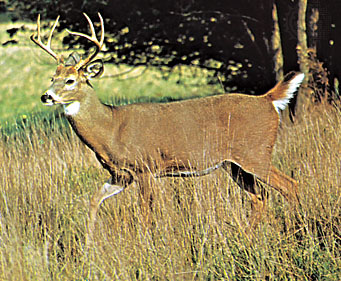

White-tailed
Deer
Odocoileus
virginianus

|
Also called VIRGINIA DEER (Odocoileus virginianus), common woodland deer, family Cervidae (order Artiodactyla), ranging from southern Canada to South America. "White-tailed deer" refers to the white underside of the tail, which is held aloft like a signaling flag when the animal is alarmed or running. An important game animal, the white-tailed deer generally lives alone or in small groups; in winter, a number may gather together, trampling down the snow in an area that then is known as a deer "yard." The white-tailed deer tends to be larger in northern areas and can stand as high as 106 cm (3 1/2 feet) at the shoulder and weigh up to 180 kg (400 pounds), and, in rare cases, more than 225 kg (500 pounds). The adult white-tailed deer has a bright reddish brown summer coat and a duller grayish brown winter coat; the underparts are white. The male has forwardly curved antlers that bear a number of unbranched tines. It thrives in open woodland (though not in mature forests), cutover forests, and woodlots on the fringes of urban areas and in farming country, often turning to orchards and other cultivated vegetation for food. Its diet includes leaves, twigs, and fruits or nuts of most vegetation, as well as lichens and other fungi. Formerly greatly reduced in its range, particularly in the United States, by unrestricted hunting, the white-tailed deer had by the mid-20th century been restored to abundance by game management measures throughout North America. Of the many subspecies, the Key deer of Florida, smallest of the white-tails, stands 76 cm (30 inches) or less at the shoulder and weighs less than 23 kg (50 pounds); formerly close to extinction, the Key deer has recovered in population as a result of protective measures. Copyright 1994-1998 Encyclopaedia Britannica |